D-Link Aquila Pro AI AX6000 Wi-Fi 6 Smart Mesh Router Review (M60-3PK)
In an era where smart devices proliferate and bandwidth demands soar, the need for a robust, future-proof Wi-Fi system has become paramount. The D-Link Aquila Pro AI M60 AX6000 Smart Mesh Router emerges as a contender in this space, promising to deliver high-performance connectivity coupled with AI-driven optimization. This comprehensive review delves into the router’s technical specifications, real-world performance, and value proposition to determine its suitability for modern home and small office networks.
Technical Specifications
HIGHLIGHTS
- Lightning-Fast Connectivity – Dual-Band AX6000 Wi-Fi 6
- Coverage With No Dead Zones – Advanced antenna design offers 360° spherical coverage plus advanced AI technology
- Grow-as-you-need Mesh – Create a robust mesh network with other AQUILA PRO AI routers and extenders
- Multi-Gigabit Wired Connections – 1 x 2.5Gbps WAN port + 4 x Gigabit LAN ports (per M60 Router)
- Help Secure Your Home Network – Advanced parental controls, IoT cybersecurity certification and WPA3 encryption
- Easy Setup and Management – The intuitive AQUILA PRO AI app guides you through setup step-by-step
- Elegant Engineering – Featuring an eagle-inspired housing and a unique feather-patterned ventilation design
- Eco-Green Design – Made with Post-Consumer Recycled case and packed in recyclable packaging
NBN/UFB Support : FTTP / FTTC/ HFC / Satellite / Fixed Wireless
Wi-Fi Technology : Wi-Fi 6 (802.11ax)
Wi-Fi Speed : AX6000 (1200 + 4800Mbps)
Wireless Bands : Dual Band
Wi-Fi Range : 3+ Bedrooms
Wi-Fi Security : Standard|Enhanced (WPA3)
Mesh Standard : D-Link Wi-Fi Mesh
WAN Interface : 2.5 Gigabit Ethernet
Ethernet Speed : Gigabit Ethernet
Ethernet Ports : 4
Guest Network : Yes
Parental Controls : Schedule|Custom Profiles|Internet Access Control
Smart Home Compatible : Amazon Alexa|Google Assistant
Firmware Upgrade : OTA Firmware Upgrade|Automatic Firmware Upgrade|Manual Fimware Upgrade
App Support : Aquila Pro AI
Warranty : 3-Year Limited Warranty
Design Philosophy and Build Quality
The packaging of a high-end router like the D-Link Aquila Pro AI M60 AX6000 play a crucial role in setting user expectations and ensuring the product’s safe arrival. D-Link has clearly invested thought into this aspect of the customer experience. With clear branding and highlighting key capabilities of the router, D-Link have put much attention to detail here.
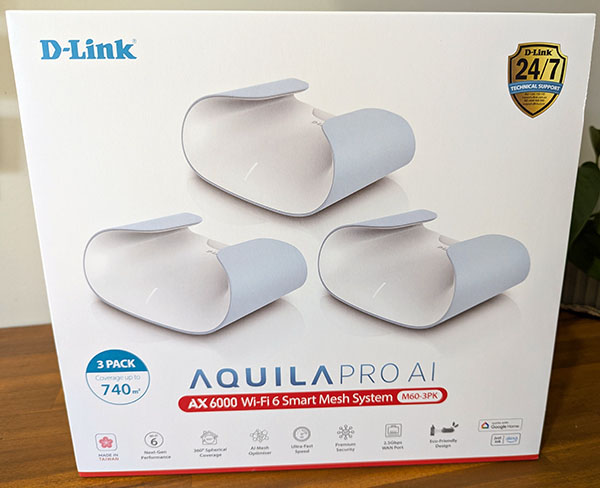
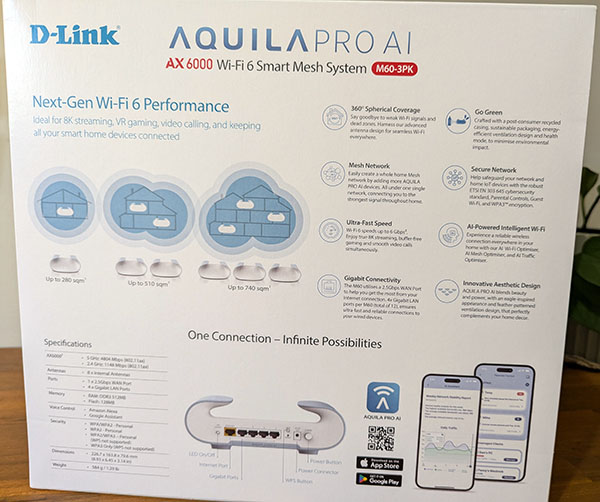
Opening up the box, you’re offered with 3 neatly packed M60 AX6000 units, power supplies for each and a single Ethernet cable.
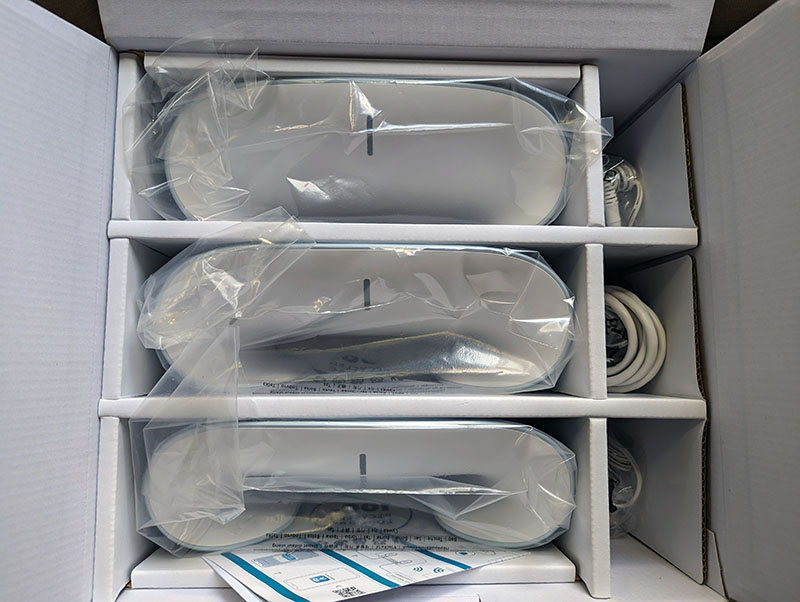
The Aquila Pro AI M60 embodies a design ethos that balances aesthetic appeal with functional consideration. Its sleek, futuristic profile, characterized by a glossy white finish and gentle contours, is clearly aimed at complementing modern interior spaces. We were impressed by the design considerations of the former model the D-Link Aquila Pro AI M30 Wi-Fi 6 Mesh which we reviewed a few months back, however the D-Link Aquila Pro AI M60 AX6000 Mesh system feels much more robust in design and feel in comparison.
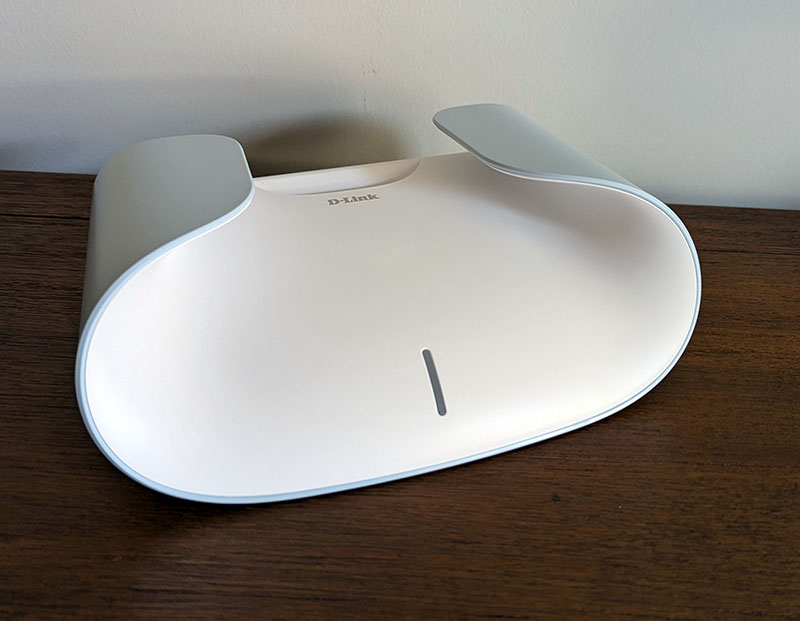
The decision to utilize internal antennas contributes to the router’s streamlined appearance while potentially sacrificing some of the signal directionality that external, adjustable antennas might offer.
From a build quality perspective, the router exhibits robust construction, suggesting durability and longevity. However, the minimalist design approach extends to the LED indicator placement, with just a single large status light at the front of the unit. While this maintains the device’s clean aesthetic, it may pose challenges for users requiring quick visual confirmation of network and service status.
Going to the connectivity options of the D-Link Aquila Pro AI M60 AX6000 you’re offered with 1 x 2.5 Gigabit Ethernet WAN connection and 4 x 1 Gig Ethernet ports per device. This effectively gives you 12 LAN ports. There’s also a separate power button to enable/disable the single LED indicator at the front.
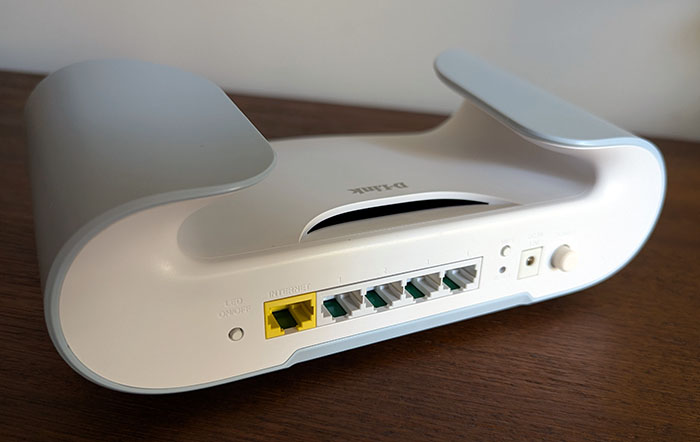
You may have to plan and trial out optimum placement for your mesh system to ensure perfect coverage across your home, however you can use D-Links product page for inspiration here https://www.dlink.com.au/home-solutions/M60-3PK-AQUILA-PRO-AI-AX6000-Mesh-System
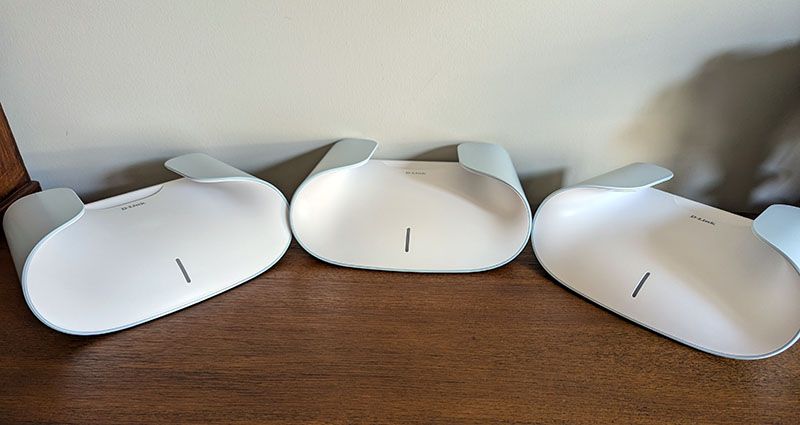
Performance Analysis
Wireless Capabilities
While the Aquila Pro AI M60’s adherence to the Wi-Fi 6 (802.11ax) standard positions it at the forefront of current widely-adopted wireless technology, it’s important to note that it does not support the emerging Wi-Fi 7 (802.11be) standard.
The theoretical maximum speed of 6000 Mbps is split between 4804 Mbps on the 5 GHz band and 1148 Mbps on the 2.4 GHz band. These speeds are particularly beneficial in environments with multiple high-bandwidth devices, such as those streaming 4K content, engaging in online gaming, or utilizing resource-intensive IoT applications.
Real-world testing corroborates the router’s capability to maintain high speeds across diverse spatial configurations. The router demonstrated impressive performance in multi-story homes, effectively penetrating walls and floors to deliver consistent speeds. In previously tested blackspot areas were showing excellent Wi-Fi signals upon switching over to the Aquila Pro AI M60.
The 4×4 MU-MIMO (Multi-User, Multiple-Input, Multiple-Output) technology further enhances the router’s ability to communicate efficiently with multiple devices simultaneously.
Coverage and Range
D-Link claims effective coverage of approximately 740 square meters, which our testing found to be generally accurate in typical residential settings. The integration of AI Beamforming technology plays a crucial role in optimizing signal strength and direction, particularly for devices at the periphery of the coverage area. For users requiring extended coverage, the router’s compatibility with D-Link’s mesh network systems provides a scalable solution and you can simply keep adding on devices as needed.
Wired Connectivity
The inclusion of a 2.5G WAN port is a forward-thinking feature, allowing for multi-gigabit internet connections. However, the limitation of Gigabit Ethernet for LAN ports may be a bottleneck for power users or small offices requiring faster wired connections for local network traffic.
AI-Driven Optimization
The integration of artificial intelligence into network management represents a significant leap in consumer router technology. The Aquila Pro AI M60 leverages AI in three key areas:
- AI Wi-Fi Optimizer: This feature continuously analyzes the local Wi-Fi environment, dynamically adjusting to minimize interference from neighboring networks and optimize channel selection. In congested wireless environments, this can lead to noticeable improvements in connection stability and throughput.
- AI Beamforming: By intelligently focusing the wireless signal towards connected devices, this technology enhances signal strength and quality, particularly at longer ranges. This can result in improved speeds and reduced latency for devices that would otherwise be at the edge of the router’s effective range.
- AI Assistant: This user-facing feature provides actionable insights and recommendations for network optimization. It’s particularly valuable for less technically inclined users, offering proactive suggestions to maintain optimal network health.
The efficacy of these AI features is most apparent in complex network environments with multiple devices and potential sources of interference. However, quantifying the exact impact of AI optimization versus traditional router firmware is challenging and may vary depending on the specific use case. During our testing we found the Aquila Pro AI M60 to be effective with AI Optimization turned off.
Security and Network Management
Setup and Management Interface
Initial setup of the Aquila Pro AI M60 is streamlined through the AQUILA PRO AI App, which provides a guided, step-by-step process. The app offers a clean, intuitive interface for day-to-day management tasks and monitoring.
For users requiring more granular control, the web-based interface provides access to advanced features such as port forwarding, QoS settings, and detailed network diagnostics. The dual interface approach effectively caters to both casual and power users.
The setup itself is pretty self explanatory and if you’re based in Australia the router firmware already has prebuilt configurations for most internet providers.
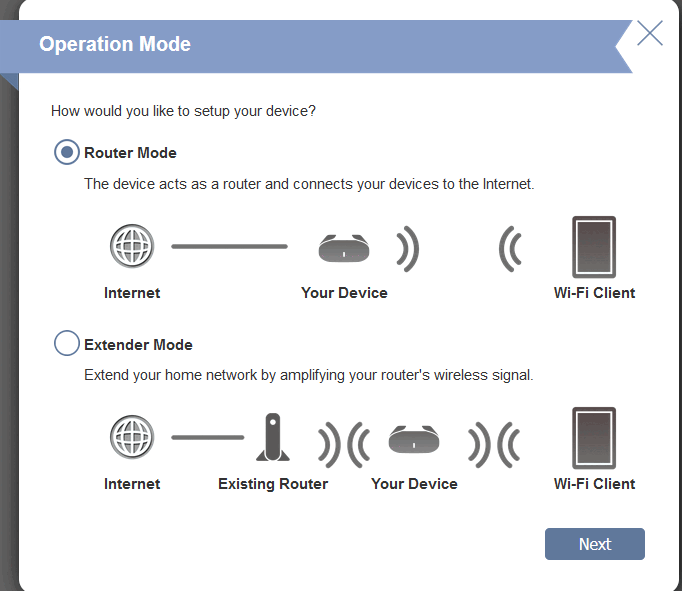
The AI Optimizer is turned on by default and you can further decide to have it optimize only during selected time periods.

You only need to configure one of the 3 routers and the remainder simply needs to be placed at its desired locations. The main router would then automatically add the detected M60 units as extenders; it’s that simple. You can click into each of the extenders to see clients connected to them. You can visibly see the clients moving from one extender to the other as you move around the house.


Parental Controls and User Management
The router’s parental control features are adequate for basic level of controls. The ability to create schedules, block inappropriate sites, and monitor internet usage provides valuable tools for managing family internet access. As with other D-Link routers, the blocking of sites was a hit and miss as it seemed to only work on certain browsers. If you really wanted more granular control for website blocking, look into setting up Pi-Hole on your network.
The controls are easily configurable through D-Link’s mobile app or via its web interface, making them accessible to users with varying levels of technical expertise.
Conclusion
The D-Link Aquila Pro AI M60 AX6000 router represents a significant advancement for home and small business environments. Its combination of Wi-Fi 6 capabilities, AI-driven optimizations, and robust security features positions it as a strong contender for users seeking a high-performance, future-proof networking solution.
As the smart home ecosystem continues to evolve and bandwidth demands increase, routers like the Aquila Pro AI M60 are likely to become increasingly relevant. At the time of writing the D-Link Aquila Pro AI M60 AX6000 3 pack system retails around AU$779.95 with some retailers discounting it around AU$600 which would be a bargain for this setup. The beauty of this system is that as your LAN requirements evolve it’s simply a matter of adding another M60 AX6000 unit into the mesh system.
Pros:
- Exceptional Wi-Fi 6 performance
- AI-driven features for continuous network optimization
- User-friendly setup and management through mobile and web interfaces
- Expandable
Cons:
- Lack of multi-gig LAN ports for high-speed local networking
- Premium pricing may be prohibitive for some users
- Absence of external antennas limits manual optimization options
- No Wi-Fi 7 support
| PERFORMANCE | |
| FEATURES | |
| VALUE | |
| BUILD QUALITY | |
|
Average
|
|
